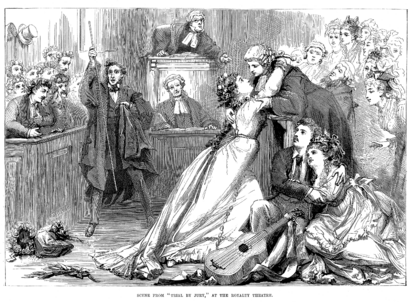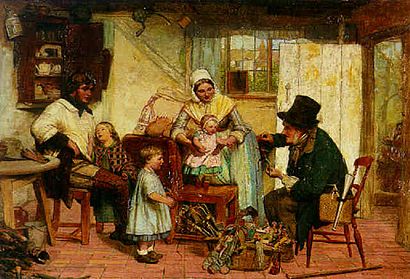David Henry Friston facts for kids

David Henry Friston (born 1820, died 1906) was a talented British illustrator and figure painter. He lived during the Victorian Era, a time when Queen Victoria ruled Britain. Friston is most famous for creating the very first pictures of Sherlock Holmes in 1887. He also drew pictures for the spooky vampire story Carmilla in 1872. Many people also know his work from the 1870s and 1880s. He drew illustrations for reviews of Gilbert and Sullivan operas and plays by W. S. Gilbert. These appeared in popular newspapers like The Illustrated London News.
Contents
Who Was David Henry Friston?
David Henry Friston was an artist who made many drawings and paintings. He worked from the 1850s until the late 1880s. His art career likely began around 1853. That year, he showed a painting called Mazeppa at the Royal Academy of Art. This was a very important art school and gallery in London.
Exhibiting His Art
Friston showed his artwork at the Royal Academy of Art 14 times. This was between 1853 and 1869. Even though he showed his work often, he never became a full member of the Academy. He also displayed at least six of his pieces at the British Institution. This happened between 1854 and 1867. In 1858, art critics saw his work A Rising Artist. They noted that Friston showed "Considerable character in the boy" in his painting.
Illustrating Books and Magazines
By 1863, Friston began drawing pictures for many books and magazines. He worked for The Churchman's Family Magazine in 1863. He also contributed to Tinsley's Magazine starting in 1867. A lot of his work appeared in the Illustrated London News from 1869 to 1878. He also drew for The Boys' Herald and Dark Blue between 1871 and 1873.
One of his early published works was a front page illustration. This was for Emma Davenport's book, Our Birthdays, and How to Improve Them (1864).
Pictures for Plays and Operas
Friston created many engravings for journals. These pictures often went with reviews of new Gilbert and Sullivan operas. He also illustrated plays by W. S. Gilbert. Some of these famous works included:
- The Princess (1870)
- Thespis (1871)
- The Wicked World (1873)
- The Realm of Joy (1873)
- The Happy Land (1873)
- Sweethearts (1874)
- Tom Cobb (1875)
- Trial by Jury (1875)
- H.M.S. Pinafore (1878)
- Princess Ida (1884)
He also illustrated a version of John Bunyan's famous book, Pilgrim's Progress. This was for the publisher Cassell.
Illustrating Classic Stories
Friston also drew pictures for short stories. One well-known example is the classic female vampire story Carmilla (1872). He also illustrated The Three Lieutenants (1874) and The Three Commanders (1875). These last two books were written by William Henry Giles Kingston. For another publisher, Groombridge, he illustrated a book of children's stories. It was called The magnet stories for summer days and winter nights.
The First Sherlock Holmes Pictures

In 1887, a company called Ward, Lock & Co. chose Friston. They wanted him to draw pictures for the very first Sherlock Holmes novel. This book was A Study in Scarlet by Arthur Conan Doyle. It was also the first adventure for the famous detective.
Friston created four pictures for the story. These drawings were then carved onto wood by W.M.R. Quick. They were published in the 1887 edition of Beeton's Christmas Annual. Friston's pictures are known as the very first images of the Sherlock Holmes character. The annual magazine came out in November and quickly sold out before Christmas.
How People Saw Friston's Holmes
Later, in 1932, a magazine called The Bookman talked about Friston's Holmes. They noted that some people didn't like his version of the detective. They said Friston's Holmes was "neither handsome nor intellectual." Another book, The Bedside, Bathtub, and Armchair Companion to Sherlock Holmes, agreed. It even called his Holmes "an outrage."
This book described Friston's drawing in detail. It said: "His head and hands appear small, almost feminine. His sideburns are ridiculously long. His figure is plump, dwarfed by the oversize coat. On his head appears a strange, rounded hat. This Holmes looks nothing like the detective we know." Even with some criticism, Friston's drawings remain important. They are the first visual ideas of Sherlock Holmes.


